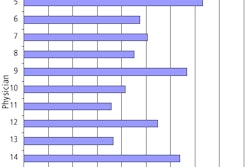ARLINGTON, VA - According to Dr. David Levin, there are three constants when nonradiologists self-refer imaging studies: overutilization, higher costs, and unnecessary testing; poor quality exams and quality assurance; and poor results from errors in interpretations.
"It's a bad situation; self-referral in imaging by nonradiologists leads to tremendous overutilization," said Levin, a professor and chairman, emeritus, at the department of radiology at Thomas Jefferson University Hospital in Philadelphia.
Levin shared results from his research into nonradiologist imaging self-referral, as well as his suggestions for curbing self-referred imaging abuse, at the Educational Symposia Economics of Diagnostic Imaging conference on Thursday.
Physician self-interest
Physician self-interest is driving the boom in self-referred imaging. According to Levin, a harsh business climate in the U.S. healthcare market has left many clinicians feeling financially beleaguered, driving them to become more business-oriented.
Federal Stark II laws, which are supposed to guard against self-referral abuse, provide an exemption for in-office ancillary services, such as imaging or laboratory testing. Nonradiologist physicians have been quick to capitalize on the lucrative technical component of Medicare payment rates for imaging services.
Figures cited by Levin showed a 62% increase in advanced imaging studies in the past two years among members of Harvard Pilgrim Healthcare of Massachusetts, while Blue Cross Blue Shield of Massachusetts saw a 20% increase in MRI studies and a 25% increase in CT studies from 2002 to 2003.
"Diagnostic imaging costs in the U.S. were approximately $75 billion in 2000 and are forecast to increase to $100 billion annually by 2005," Levin said, citing a Blue Cross Blue Shield Association report.
Not surprisingly, nonradiologist physicians are reluctant to give up the cash cow of in-office imaging, even claiming that attempts are being made to curtail their business by limiting the use of technology and competition, according to Levin.
State self-interest
The state of Maryland has carved out specific exceptions for CT, MRI, and radiation therapy to the in-office ancillary services clause in its legislation prohibiting physician self-referral. Although the law has been on the books, enforcement of the prohibitions against advanced imaging had not been enforced, Levin said.
That changed earlier this year when the Maryland attorney general issued a comment about an orthopedic group's ownership of an MR scanner.
"In our opinion, state law bars a physician in an orthopedic group practice from referring patients for tests on an MRI machine or CT scanner owned by that practice, regardless of whether the services are performed by a radiologist employee or member of the practice or by an independent radiology group. The same analysis holds true for any other nonradiology medical practice," Levin reported.
In addition to creating exemptions for imaging services in ancillary services definitions, Levin recommended that states that require certificates of need (CON) for the purchase of imaging equipment apply the requirement across all consumers of imaging modalities.
"In New York, for example, hospitals must get a CON for an MRI, but private physician offices don't have to," he said.
Payor self-interest
States aren't the only entities recognizing the economic havoc being wrought by unrestricted self-referred in-office imaging. Some healthcare payors have recently enacted imaging reimbursement restrictions in an effort to cap the monetary gush flowing to nonradiologist physicians.
In 1996 Cigna HealthCare of Connecticut instituted a program of quality standards inspections to ensure that x-ray and ultrasound studies being performed by nonradiologists met acceptable standards of practice for reimbursement. Levin said that 78% of the 92 nonradiology facilities inspected had significant deficiencies.
He also noted that in 1997, a year after the quality standards inspections were instituted, Cigna saw a 6% decline in the number of x-ray studies per 1,000 lives that were submitted for reimbursement. Of the 411 nonradiologist offices that conducted imaging studies in 1995, 132 stopped billing Cigna. In addition, 46 ob/gyn groups were unwilling or unable to get ultrasound accreditation and were dropped by the payor.
More recently, the Blue Cross Blue Shield insurer for western Pennsylvania instituted a requirement that any group billing for diagnostic imaging services had to provide a minimum of five imaging modalities and have a radiologist on-site during business hours in order to be reimbursed, he said.
Levin recommended that states and payors adopt the following guidelines for nonradiologist-conducted diagnostic imaging:
- Mandatory accreditation or site inspections of all imaging facilities along the same lines as mammography quality assurance.
- Limit imaging privileges among nonradiologists by requiring certification from the Centers for Medicare and Medicaid Services (CMS) as diagnostic imaging providers, as well as from appropriate accrediting bodies such as the American Institute of Ultrasound in Medicine (AIUM), the American College of Radiology (ACR), etc.
- Preauthorization for all CT, MR, PET, and nuclear cardiology studies performed by nonradiologists.
- Services on leased equipment will not be covered unless the lease is on a full-time basis.
- All imaging studies must include a written report.
- Institute or reinstitute CON laws across all imaging facilities.
- Exempt CT, MR, and PET from in-office ancillary services.
- Pay less for self-referred studies by nonradiologists.
"What all of us in the radiology community have to do is push for these kinds of reforms to be made," he said.
By Jonathan S. Batchelor
AuntMinnie.com staff writer
October 29, 2004
Related Reading
Self-referral issue isolates radiology in multispecialty forum, October 7, 2004
Stark II interim final rule leaves huge self-referral loophole, July 20, 2004
The impact of phase II Stark regulations on freestanding imaging centers, May 13, 2004
Medicare database shows cardiologists driving up imaging costs, January 9, 2004
Copyright © 2004 AuntMinnie.com



















